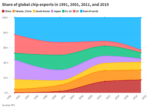Chip industry’s complicated contours decades in the making
The mixture of happenstance and geostrategy that helped make a small European country key to the global semiconductor market is depicted in delicious detail in Chris Miller’s “Chip War.” The book couldn’t have been timed better. Miller, an associate professor of international history at the Fletcher School, uses a colorful cast of characters to tell the story of a truly pivotal industry’s formation, and explain why altering it in a meaningful way seems unlikely any time soon – regardless of mounting geopolitical pressure. Chips are coveted not least for the role they play in artificial intelligence tools seemingly poised to shake things up for just about everyone. The more we want them, though, the more expensive and difficult they are to make. It’s all gotten very complicated. Take the Dutch niche in the supply chain, for example – it’s based on one company’s machine “that took tens of billions of dollars and several decades to develop,” Miller writes, and uses light to print patterns on silicon by deploying lasers that can hit 50 million tin drops per second. It’s an industry full of such mind-bending extremes. In an interview with the Forum’s Radio Davos podcast, Miller marvelled at having recently visited a facility in the US being built with “seventh-biggest crane that exists in the world,” which will eventually assemble chips mounted with transistors “roughly the size of a coronavirus.” Nvidia, the company now most closely identified with chips powering artificial intelligence, features prominently in Miller’s book. The company traces its roots to a meeting at a 24-hour diner on the fringes of Silicon Valley, he writes. At a certain point it realised that its semiconductors used for video-game graphics could do a good job of training AI systems. Earlier this year, its market value increased by $184 billion in a single day. Nvidia’s chips aren’t made anywhere near […]









